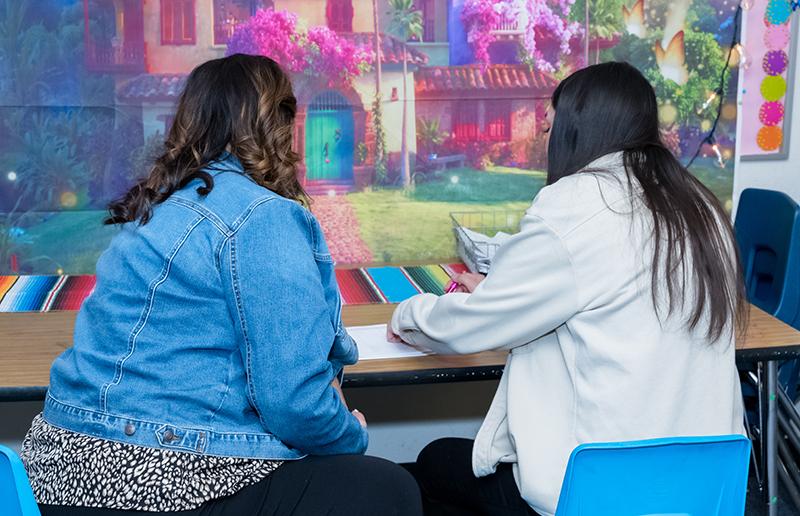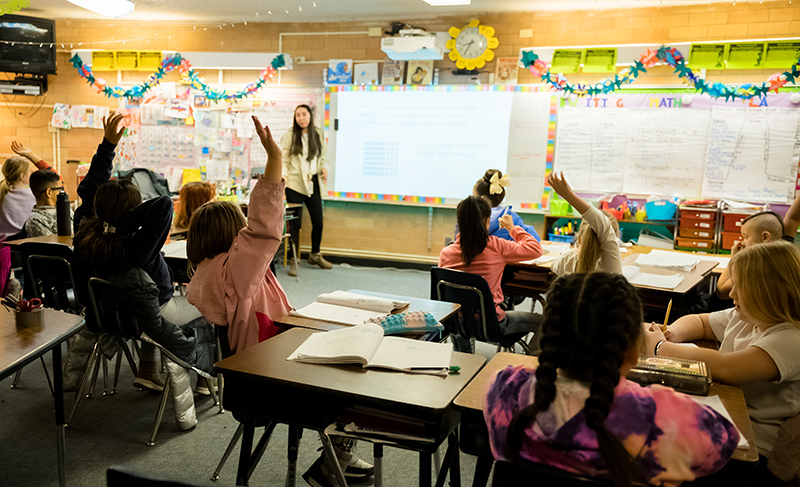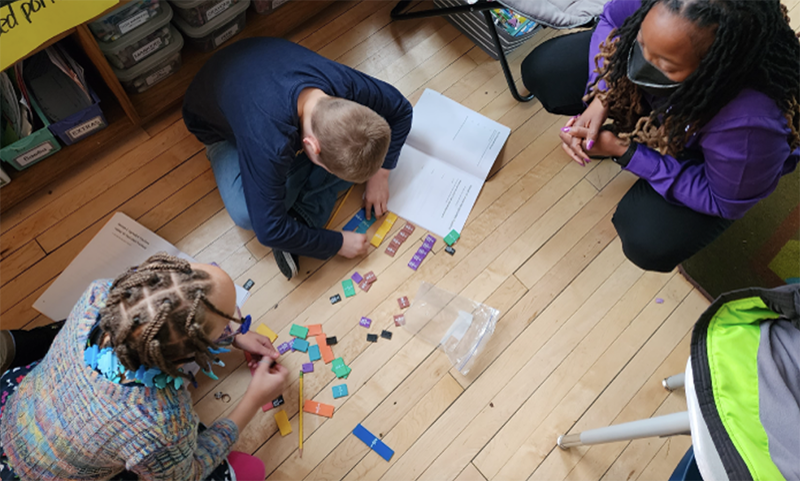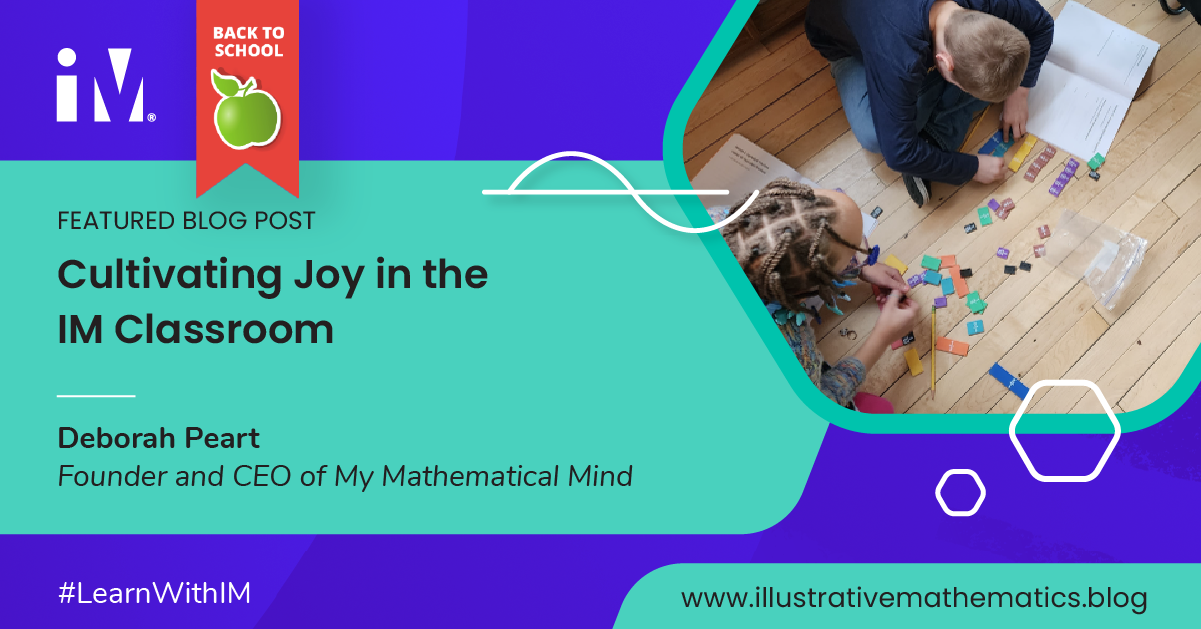By Deborah Peart, Founder and CEO of My Mathematical Mind
If we want students to Know, Use, and EnJOY mathematics, it begins with teachers. Joyous math experiences are about more than having fun and keeping students happy in math class. Happiness is a state of mind that shifts based on external forces, while joy comes from within and can be experienced in spite of our current circumstances. In the words of J.D. Salinger, “The fact is always obvious much too late, but the most singular difference between happiness and joy is that happiness is a solid and joy is a liquid.” Teachers who genuinely love teaching mathematics ooze joy!
Teachers implementing a new curriculum with a problem-based approach can experience shaky confidence, which could lead to a less than joyous math experience. It’s a good thing the IM curriculum includes features to support teachers with their professional growth and a design structure that can help create the conditions for building a community of mathers. Teachers have the opportunity to learn about the math content and instructional practices in manageable bites because of the intentional design of the teacher resources.
Developing a Practice to Cultivate Joy
The narratives are an important feature that support teachers as they deepen their understanding of the content and pedagogy. At the unit, section, lesson, and activity level, teachers will find detailed information about the mathematical story of the unit, learning goals, and expected student outcomes. While planning for instruction, teachers can find the information needed to support their understanding of the math content, the underpinnings of the mathematical concepts presented, and the anticipated student strategies and partial conceptions. The educative nature of the curriculum is a feature that, when leveraged, can consistently make an impact on the professional development of educators and their confidence with teaching mathematics.

In addition to the narratives, there are curriculum features that provide teachers with opportunities to plan together using lessons tagged for professional learning communities because collaboration is important to the implementation process. Educators can plan together, encourage one another, persist together, and celebrate wins together. Teams can consider potential adaptations and supports needed as they do the work of the lesson together. By solving problems together, sharing thinking, and connecting mathematical ideas with their colleagues, teachers have the time and space to process information and prepare to probe student thinking with questions. The Advancing Student Thinking and Response to Student Thinking features in the K-5 materials provide prompts to support teachers with questioning and pushing students to think critically about their mathematical ideas.
Lastly, teams can reflect on their practices, using the guidance of teacher reflection questions or based on observations and feedback cycles. Being reflective allows you to celebrate your successes and pivot when needed, in order to experience the joy that comes with personal and professional growth.
Making the adjustments needed to implement a problem-based curriculum can be daunting, but with the right support it can be empowering. It is critically important for teachers to know, use, and enjoy mathematics in order to support student learning and nurture positive math identities. Understanding the content and feeling prepared to answer questions results in confidence, and reflection leads to change. Confident teachers can experience joy and create joyful math experiences for their students.
Inviting Students to EnJOY Mathematics
Creating a sense of belonging for students is necessary to ensure that they feel safe to take risks and share their ideas. The structure of the IM curriculum is invitational and includes features designed to establish a strong sense of community. Of course, it is the teacher who sets the tone and invites students to enjoy learning together by talking about mathematics from a joyful place. An important factor in student engagement is students believing that their ideas will be heard and valued. Every day, at the start of each lesson students get the chance to share in a way that is nonthreatening and provides an opportunity to spark joy. Teachers who start each math lesson with these predictable routines will reap the benefits of students feeling comfortable sharing their strategies and making connections with their classmates.

Warm-up routines are the first math experiences students will have each day. They are meant to happen at the beginning of the lesson and not last more than 10 minutes. There is a limited variety of routines throughout the curriculum across grade levels, so students become familiar with them and can take comfort in knowing how the routines work even when the skills or concepts are unfamiliar. Whether the warm-up is open-ended or focused on specific strategies or representations, teachers can support students as they make connections between their ideas and the ideas of other students. These opening activities allow students to engage in math discourse, make mistakes without consequence, and debate their developing ideas with friends.
Establishing norms for this special time will help students feel more at ease with justifying their reasoning and critiquing the reasoning of others. Hopefully, this is also the time of day that might include a few giggles and feel playful. Teachers can model the joy that talking about your mathematical ideas with friends can bring, and inspire students to approach math time with a ready mind and a smile.
Embracing Challenges as a Source of Joy
“Productive struggle” continues to be a term that is overused and interpreted differently across the field. One aspect of productive struggle that is addressed by a problem-based instructional model is that students are the ones doing the thinking. In contrast to other instructional models, which give explicit steps to follow before giving students the opportunity to make sense of the problems for themselves, the problem-based structure positions the teacher as a facilitator of learning who guides without rescuing.

Collaborative learning cultivates joy, but in many math classrooms, students are discouraged from working together to solve problems. Some argue that you cannot gain an accurate picture of what each student knows if they work in groups. Some lack confidence in their students’ ability to work together without chaos erupting. Others view classwork time as rehearsal for standardized testing: no talking, no sharing, and no deep thinking. While students need independent thinking time to formulate their own ideas, partner work and group work foster relationships and provide space for discourse that deepens understanding. Students take time with their peers to recognize mistakes, learn from them, and find value in hearing multiple perspectives or trying different solution paths. Ultimately, students experience collective agency by sharing math challenges and experiencing Aha! moments together.

Imagine the joy students feel when they are faced with challenges and given the chance to find their own solutions. Of course teachers support from the side, pushing students’ thinking with questions, and cheering them on for persisting. Students learn to try, fail, and try again. Classmates develop collective agency as they support one another by sharing their ideas, leveraging mistakes as opportunities for learning, and celebrating their victories. The teacher who establishes a culture where students rise to challenges and a community where students encourage each other will bear witness to math joy.
Conclusion
Creating the conditions for cultivating joy will take time, but a wonderful place to start is with shifting mindsets and beliefs about what it means to be good at math. Disrupting the narrative that being the fastest, always getting the right answer, or being the most vocal in math class means that you are the best at doing math is critical to creating a sense of belonging for all types of math thinkers. Teachers who are confident in their ability to teach mathematics, take time to play with mathematical ideas, and collaborate with others are more likely to experience math joy and share that joy with their students. Students who see their teachers learning alongside them, struggling productively, leveraging mistakes as opportunities for growth, and, most importantly, smiling and laughing as they share mathematical ideas and concepts are positioned to know, use, and enJOY mathematics.
Next Steps
Proud moments of accomplishing goals, teacher praise framed as meaningful feedback, and collective agency among students cultivate joy.
How will you cultivate the joy of math learning in your classroom this year?
 Deborah Peart
Deborah Peart
Founder and CEO of My Mathematical Mind
Deborah Peart is the founder and CEO of My Mathematical Mind. She speaks on a variety of topics related to math identity, math content, instructional practices, and literacy connections to mathematics. Blending her training in yoga and mindfulness with mathematics instruction, Deborah advocates for a mindful approach to teaching mathematics in order to address math anxiety, build confidence, and support the development of positive math identities. She has dedicated her career to supporting educators with innovative teaching strategies that allow students to see themselves as assets to the learning community and curious problem-solvers. She is the lead author for second grade for the Illustrative Mathematics K-5 curriculum. Deborah believes that all children deserve high quality instruction and the opportunity to become competent readers, writers, and mathers.
